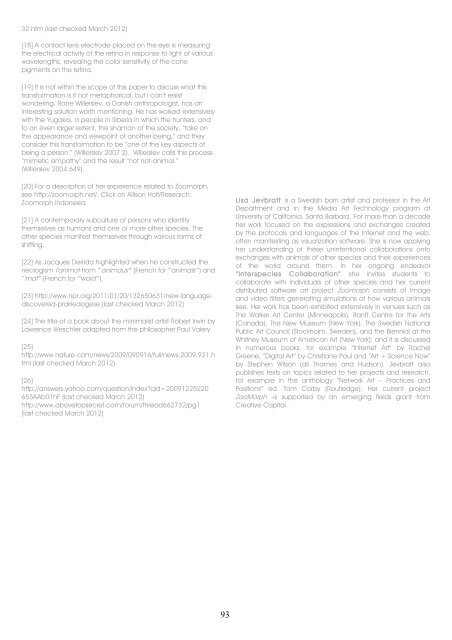Animal Influence I - Antennae The Journal of Nature in Visual Culture
Animal Influence I - Antennae The Journal of Nature in Visual Culture
Animal Influence I - Antennae The Journal of Nature in Visual Culture
Create successful ePaper yourself
Turn your PDF publications into a flip-book with our unique Google optimized e-Paper software.
32.htm (last checked March 2012)<br />
[18] A contact lens electrode placed on the eye is measur<strong>in</strong>g<br />
the electrical activity <strong>of</strong> the ret<strong>in</strong>a <strong>in</strong> response to light <strong>of</strong> various<br />
wavelengths, reveal<strong>in</strong>g the color sensitivity <strong>of</strong> the cone<br />
pigments on the ret<strong>in</strong>a.<br />
[19] It is not with<strong>in</strong> the scope <strong>of</strong> this paper to discuss what this<br />
transformation is if not metaphorical, but I can’t resist<br />
wonder<strong>in</strong>g. Rane Willerslev, a Danish anthropologist, has an<br />
<strong>in</strong>terest<strong>in</strong>g solution worth mention<strong>in</strong>g. He has worked extensively<br />
with the Yugakirs, a people <strong>in</strong> Siberia <strong>in</strong> which the hunters, and<br />
to an even larger extent, the shaman <strong>of</strong> the society, “take on<br />
the appearance and viewpo<strong>in</strong>t <strong>of</strong> another be<strong>in</strong>g,” and they<br />
consider this transformation to be “one <strong>of</strong> the key aspects <strong>of</strong><br />
be<strong>in</strong>g a person.” (Willerslev 2007 2). Willerslev calls this process<br />
“mimetic empathy” and the result “not not-animal.”<br />
(Willerslev 2004 649).<br />
[20] For a description <strong>of</strong> her experience related to Zoomorph,<br />
see http://zoomorph.net/. Click on Allison Holt/Research:<br />
Zoomorph Indonesia.<br />
[21] A contemporary subculture <strong>of</strong> persons who identify<br />
themselves as humans and one or more other species. <strong>The</strong><br />
other species manifest themselves through various forms <strong>of</strong><br />
shift<strong>in</strong>g.<br />
[22] As Jacques Derrida highlighted when he constructed the<br />
neologism l’animot from “‘animaux”’ (French for “‘animals’”) and<br />
“‘mot’” (French for “‘word’”).<br />
[23] http://www.npr.org/2011/01/20/132650631/new-languagediscovered-prairiedogese<br />
(last checked March 2012)<br />
[24] <strong>The</strong> title <strong>of</strong> a book about the m<strong>in</strong>imalist artist Robert Irw<strong>in</strong> by<br />
Lawrence Weschler adapted from the philosopher Paul Valery.<br />
[25]<br />
http://www.nature.com/news/2009/090916/full/news.2009.921.h<br />
tml (last checked March 2012)<br />
[26]<br />
http://answers.yahoo.com/question/<strong>in</strong>dex?qid=20091225220<br />
653AAb01hF (last checked March 2012)<br />
http://www.abovetopsecret.com/forum/thread662732/pg1<br />
(last checked March 2012)<br />
93<br />
Lisa Jevbratt is a Swedish born artist and pr<strong>of</strong>essor <strong>in</strong> the Art<br />
Department and <strong>in</strong> the Media Art Technology program at<br />
University <strong>of</strong> California, Santa Barbara. For more than a decade<br />
her work focused on the expressions and exchanges created<br />
by the protocols and languages <strong>of</strong> the Internet and the web,<br />
<strong>of</strong>ten manifest<strong>in</strong>g as visualization s<strong>of</strong>tware. She is now apply<strong>in</strong>g<br />
her understand<strong>in</strong>g <strong>of</strong> these un<strong>in</strong>tentional collaborations onto<br />
exchanges with animals <strong>of</strong> other species and their experiences<br />
<strong>of</strong> the world around them. In her ongo<strong>in</strong>g endeavor<br />
“Interspecies Collaboration” she <strong>in</strong>vites students to<br />
collaborate with <strong>in</strong>dividuals <strong>of</strong> other species and her current<br />
distributed s<strong>of</strong>tware art project Zoomorph consists <strong>of</strong> image<br />
and video filters generat<strong>in</strong>g simulations <strong>of</strong> how various animals<br />
see. Her work has been exhibited extensively <strong>in</strong> venues such as<br />
<strong>The</strong> Walker Art Center (M<strong>in</strong>neapolis), Banff Centre for the Arts<br />
(Canada), <strong>The</strong> New Museum (New York), <strong>The</strong> Swedish National<br />
Public Art Council (Stockholm, Sweden), and the Biennial at the<br />
Whitney Museum <strong>of</strong> American Art (New York); and it is discussed<br />
<strong>in</strong> numerous books, for example “Internet Art” by Rachel<br />
Greene, “Digital Art” by Christiane Paul and “Art + Science Now”<br />
by Stephen Wilson (all Thames and Hudson). Jevbratt also<br />
publishes texts on topics related to her projects and research,<br />
for example <strong>in</strong> the anthology “Network Art – Practices and<br />
Positions” ed. Tom Corby (Routledge). Her current project<br />
ZooMorph is supported by an emerg<strong>in</strong>g fields grant from<br />
Creative Capital.












